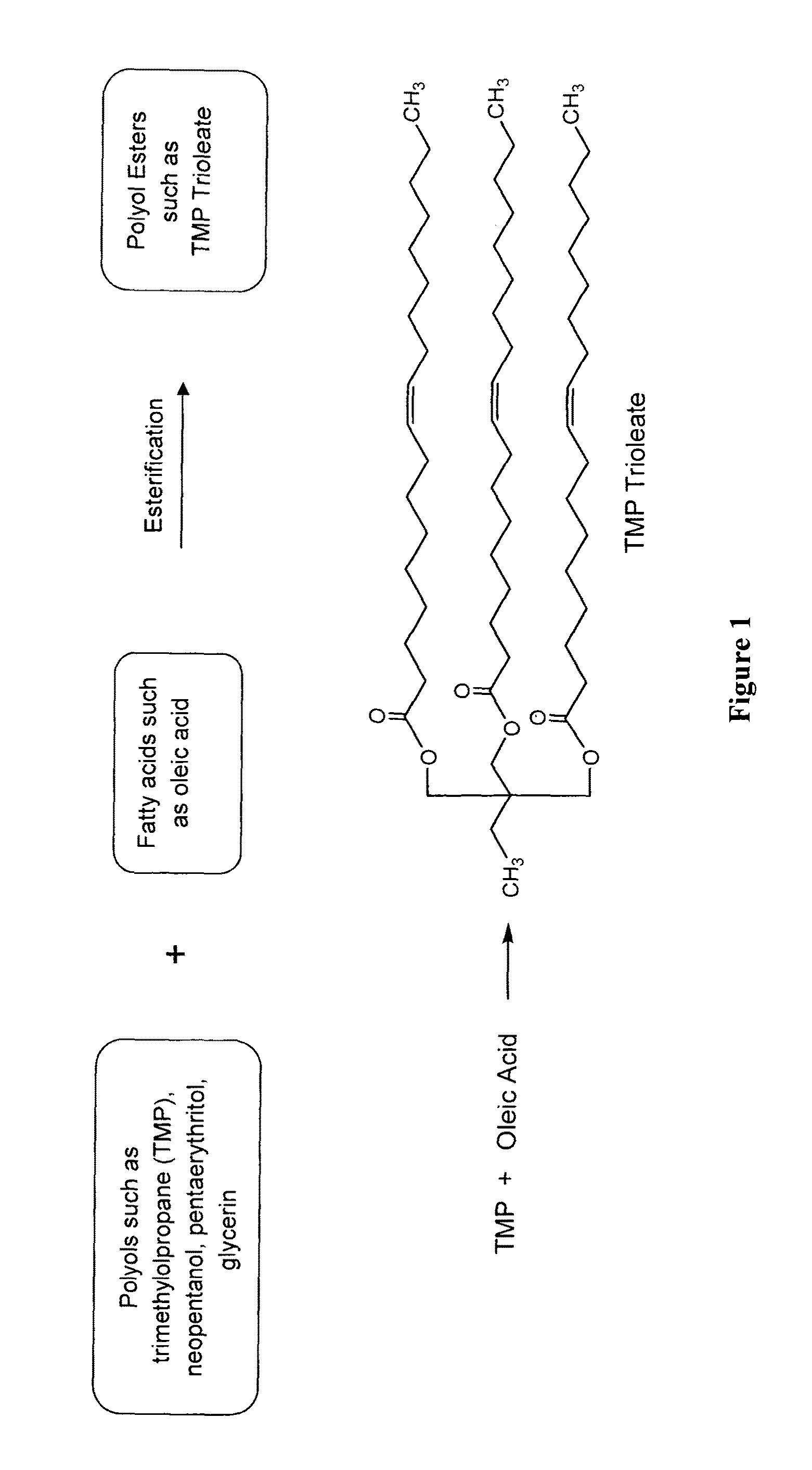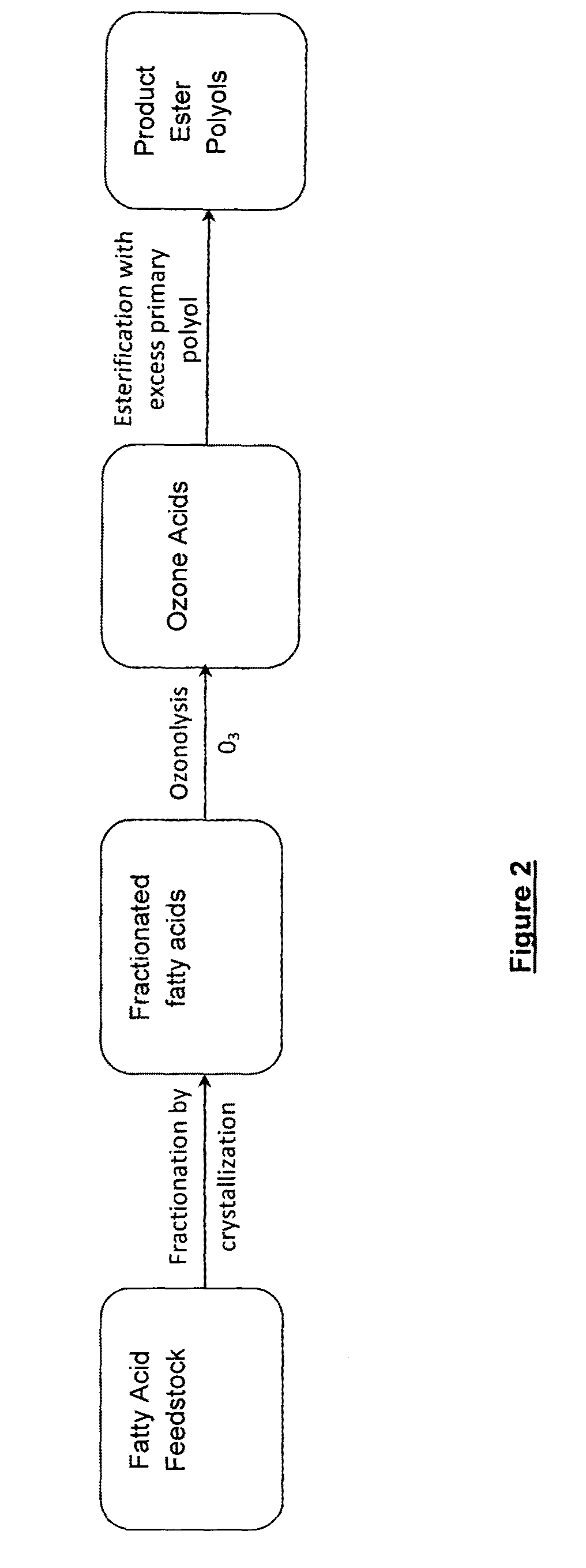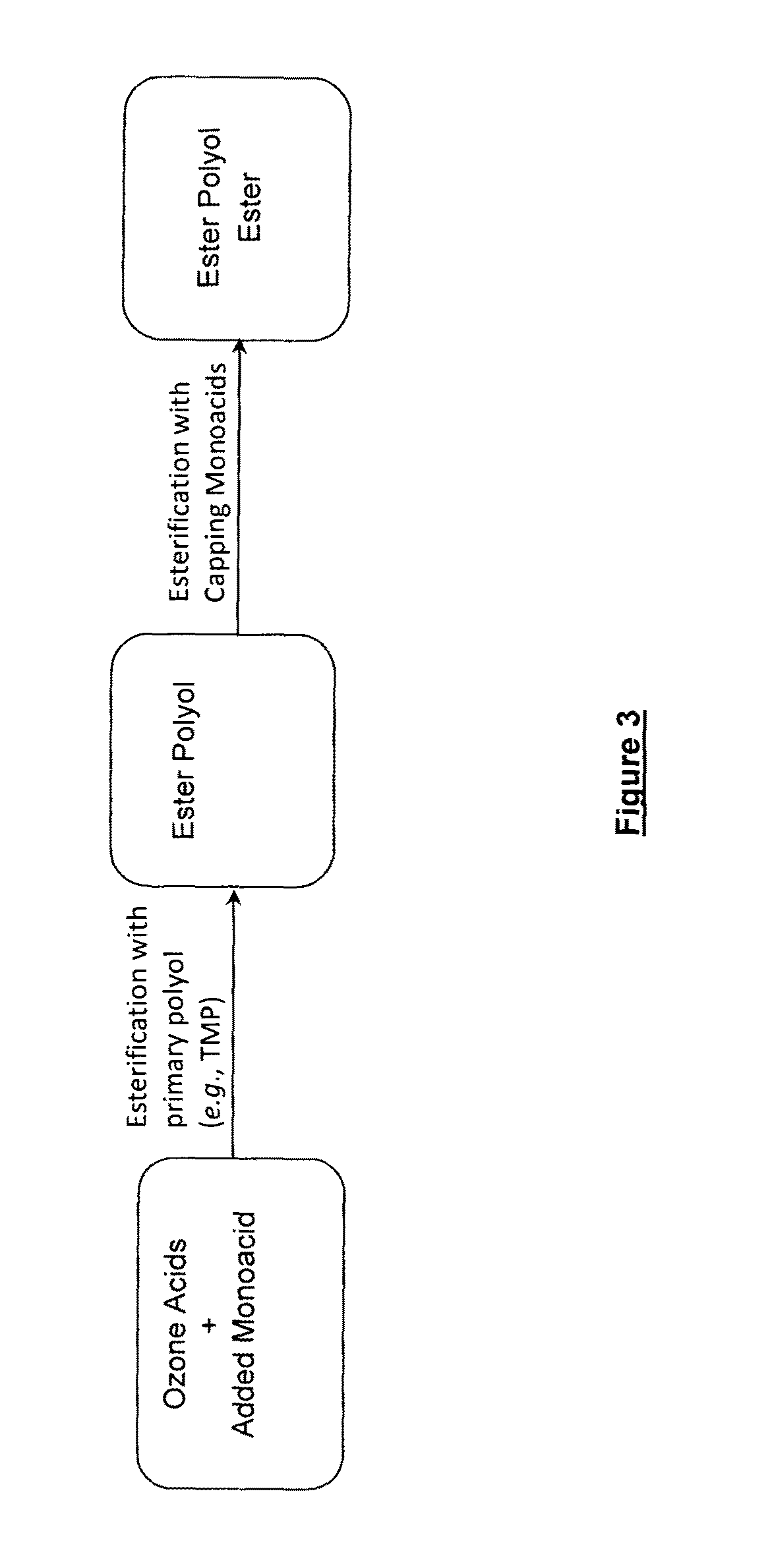The preparation of biopolyol esters for lubricant application
- Summary
- Abstract
- Description
- Claims
- Application Information
AI Technical Summary
Benefits of technology
Problems solved by technology
Method used
Image
Examples
example 1
Result
[0134]
Polyol EsterNoDescriptionUnitMethodLB251Appearance—VisualB&C2Kinematic Viscosity,° C.ASTM D44543.39940° C.3Kinematic Viscosity,° C.ASTM D4458.864100° C.4Viscosity Index—ASTM D22701545Colour—ASTM D1500L06Total Acid NumbermgKOH / gASTM D6640.57Pour Point° C.ASTM D97−548Flash Point° C.ASTM D92>250
Example 2
1-Step Process Using Palm Based Ozone Acids
Lubricant 25 cSt
[0135]Azelaic acid: 2.69 wt %
Pelargonic acid: 75.87 wt %
Trimethylolpropane (TMP): 21.43 wt %
Catalyst: 0.03 wt %
[0136]The palm based ozone acids and polyhydric alcohol were mixed in the round bottom flask fitted with a gas inlet tube fitted with a gas dispersing block, a mechanical stirrer, a distillation column fitted with a cooled condenser and collection flask to collect distilled water. The mixture was initially homogenized at 100° C. using mechanical stirring. The temperature was increased to activate the catalyst. The temperature was then increased to 180° C. and subsequently to 210° C. In order to drive the est...
example 2
Result
[0137]
Polyol EsterNoDescriptionUnitMethodLB251Appearance—VisualB&C2Kinematic Viscosity, 40° C.° C.ASTM D44525.3913Kinematic Viscosity, 100° C.° C.ASTM D4455.3394Viscosity Index—ASTM D22701505Colour—ASTM D1500L06Total Acid NumbermgKOH / gASTM D6640.397Pour Point° C.ASTM D97−548Flash Point° C.ASTM D922649Metal Analysis (Tin Content), ICPPpmASTM D49510104 BallMmASTM D41720.7 × 0.711Compositional Analysis, TGA—ASTM E113186.76%9.295%2.734&12Oxidative Stability, DSC° C.201.0213Hydrolytic StabilityASTM D2619TAN before hydrolytic stabilitymgKOH / g0.58TAN after hydrolytic stabilitymgKOH / g1.16Water aciditymgKOH / g5.23Weight loss of copper stripmg / cm20.11Appearance of the copper stripcSt1BOil viscosity at 40° C. before hydrolyticcSt25.30stabilityOil viscosity at 40° C. after hydrolytic stability%25.58Viscosity loss1.1014Biodegradability%OECD 301B75.7
Example 3
1-Step Process Using Palm Based Ozone Acids
Lubricant 44 cSt
[0138]Azelaic acid: 9.64 wt %
Pelargonic acid: 67.86 wt %
Trimethylolpropane (...
example 3
Result
[0140]
Polyol EsterNoDescriptionUnitMethodLB441Appearance—VisualB&C2Kinematic Viscosity, 40° C.° C.ASTM D44546.3293Kinematic Viscosity, 100° C.° C.ASTM D4458.3564Viscosity Index—ASTM D22701585Colour—ASTM D1500L0.56Total Acid NumbermgKOH / gASTM D6640.68ePour Point° C.ASTM D97−578Flash Point° C.ASTM D92>2509Metal Analysis (Tin Content), ICPPpmASTM D49510104 BallMmASTM D41720.7 × 0.711Compositional Analysis, TGA—ASTM E113160.52%29.27%7.856&12Oxidative Stability, DSC° C.201.6113Hydrolytic StabilityASTM D2619TAN before hydrolytic stabilitymgKOH / g0.84TAN after hydrolytic stabilitymgKOH / g1.76Water aciditymgKOH / g12.99Weight loss of copper stripmg / cm20.18Appearance of the copper stripcSt1BOil viscosity at 40° C. before hydrolytic stabilitycSt46.25Oil viscosity at 40° C. after hydrolytic stability%46.87Viscosity loss1.3414Biodegradability%OECD 301B83.6
Example 4
1-Step Process Using Palm Based Ozone Acids
Lubricant 100 cSt
[0141]Azelaic acid: 16.79 wt %
Pelargonic acid: 59.61 wt %
Trimethylolpr...
PUM
| Property | Measurement | Unit |
|---|---|---|
| Temperature | aaaaa | aaaaa |
| Fraction | aaaaa | aaaaa |
| Fraction | aaaaa | aaaaa |
Abstract
Description
Claims
Application Information
 Login to View More
Login to View More - R&D
- Intellectual Property
- Life Sciences
- Materials
- Tech Scout
- Unparalleled Data Quality
- Higher Quality Content
- 60% Fewer Hallucinations
Browse by: Latest US Patents, China's latest patents, Technical Efficacy Thesaurus, Application Domain, Technology Topic, Popular Technical Reports.
© 2025 PatSnap. All rights reserved.Legal|Privacy policy|Modern Slavery Act Transparency Statement|Sitemap|About US| Contact US: help@patsnap.com



